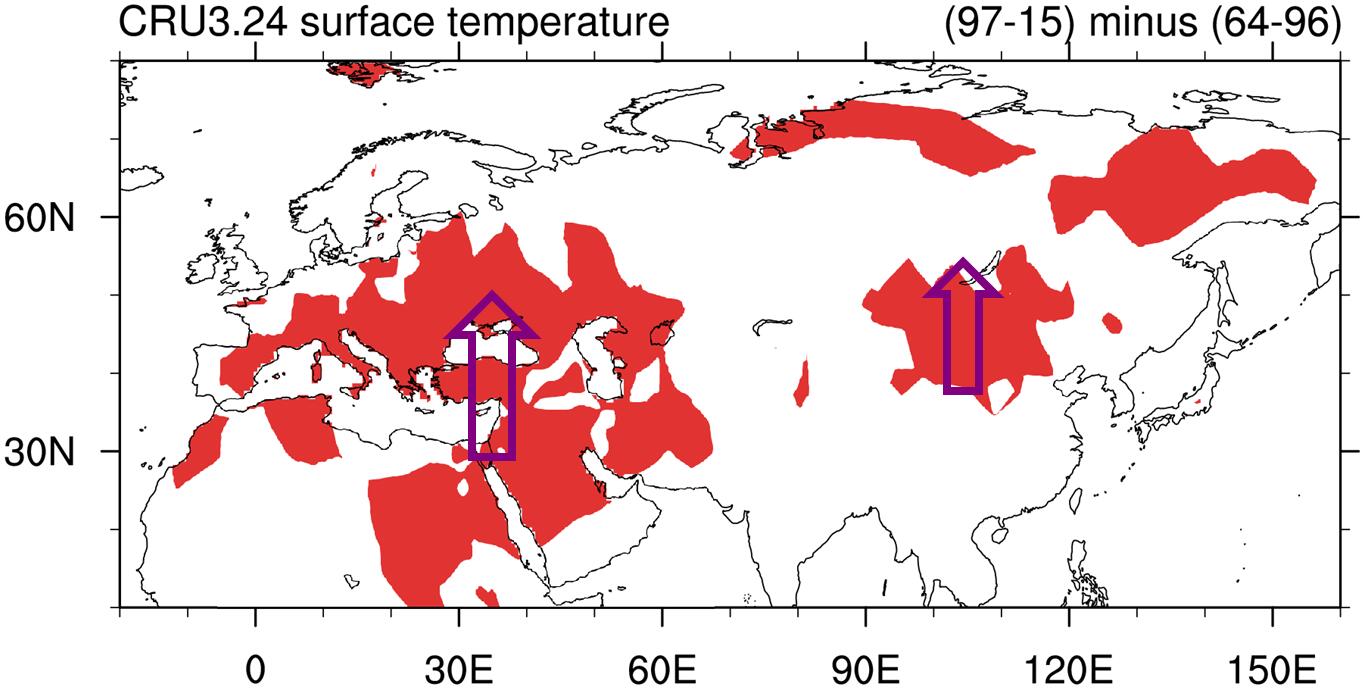After the mid-1990s, the global surface temperature presents a significant warming trend. According to the World Meteorological Organization, the global mean surface temperature of the period 2011–2015 has increased by 0.57℃ than that of 1961–1990. This warming trend provides favorable background for occurrence of hot summers, and inflames the hot extreme events. Based on statistics, the casualties caused by hot events during 2001–2010 have increased by twenty-three times relative to those during 1991–2000.

Changes in surface temperature between the averages during 1997–2015 and 1964–1996. Only regions where the temperature increase exceeding 1℃ are given (red shading). Vectors indicated regions of the amplified warming. (Image by HONG Xiaowei)
This warming trend is particularly prominent in the boreal mid- and high- latitudes. Europe's 2003 heat wave, for instance, has brought about more than 30, 000 deaths. In 2010, the maximum temperature of several cities in Russia exceeded 40℃, being about twice of the climatological value (23℃). This heat attack led to at least 15, 000 deaths and more than $15 billion economic loss. In the same year, the Mohe country, which located in the northern most of China, also made a high historical record, with its daily maximum temperature being 39.3℃. Actually, the northeast region of China is a key base for commercial food production. During the past decade, the cultivated land over this domain has extended by more than 30 percent. This somewhat relates to the warming climate and longer duration of summer season in this region.
Against the background of global warming, amplitudes of the warmth differ much between different regions. This is an issue to be addressed in the climate change investigation.
A recent research by Institute of Atmospheric Physics, Chinese Academy of Sciences identified a nonuniform warming pattern in summer after the mid-1990s over the Eurasian continent, with a predominant amplified warming over Europe-West Asia and Northeast Asia but much weaker warming over Central Asia. They suggest that the Atlantic Multidecadal Oscillation may induce this asymmetry in temperature changes through the decadal change of the Silk Road Pattern. The so-called Silk Road Pattern, is a wave-like pattern along the upper-tropospheric westerly jet in midlatitudes. Their results show that the Silk Road Pattern has a strong decadal variability, which can explain about 30% of its total variance.
Considering that the AMO has a cycle of about 65–80 years and has entered into a positive phase since the mid-1990s, it implies that there will still be a strong warming over Europe-West Asia and Northeast Asia in the coming decade. And this would exert great influence on the ecological condition, the agriculture, and the human life.
Reference
Hong X, R Lu, and S Li 2017 Amplified summer warming in Europe-West Asia and Northeast Asia after the mid-1990s Environ. Res. Lett. (Published online at http://iopscience.iop.org/article/10.1088/1748-9326/aa7909)
Contact: LU Riyu, lr@mail.iap.ac.cn
